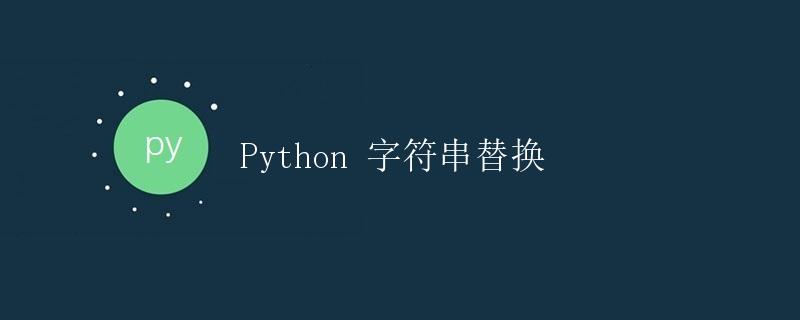Python 字符串替换

1. 引言
在 Python 中,字符串是一种常见的数据类型。在处理字符串时,经常需要进行替换操作,即将原字符串中的某个子串替换为另一个子串。Python 提供了多种方法来进行字符串替换,本文将详细讨论这些方法的用法和特点。
2. 字符串的替换方法
在 Python 中,字符串的替换可以使用 replace() 方法、正则表达式以及字符串模板等方法。下面分别介绍这些方法的使用。
2.1 replace() 方法
replace() 方法是 Python 原生的字符串方法,用于将字符串中的某个子串替换为另一个指定的子串。其语法如下:
str.replace(old, new[, count])
其中,str 是原字符串,old 是需要被替换的子串,new 是用来替换的子串。可选的 count 参数指定替换次数,默认为替换所有匹配项。
示例代码如下:
str1 = "Hello, world!"
new_str1 = str1.replace("world", "Python")
print(new_str1) # 输出 "Hello, Python!"
str2 = "Hello, hello, hello!"
new_str2 = str2.replace("hello", "Hi", 2)
print(new_str2) # 输出 "Hi, Hi, hello!"
2.2 正则表达式
正则表达式是一种强大的字符串匹配工具,可以在字符串中匹配和替换符合某种模式的子串。通过 re 模块,Python 提供了对正则表达式的支持。
使用正则表达式进行字符串替换的基本步骤如下:
- 导入
re模块。 - 使用
re.sub(pattern, repl, string[, count])方法进行替换,其中pattern是要匹配的正则表达式模式,repl是用来替换的字符串,string是原字符串。
示例代码如下:
import re
str1 = "Hello, world!"
new_str1 = re.sub(r"world", "Python", str1)
print(new_str1) # 输出 "Hello, Python!"
str2 = "Hello, hello, hello!"
new_str2 = re.sub(r"hello", "Hi", str2, 2)
print(new_str2) # 输出 "Hi, Hi, hello!"
2.3 字符串模板
字符串模板是一种通过预定义的模板文件来生成字符串的方法。在模板文件中,可以使用占位符来标识需要被替换的部分。Python 提供了 string.Template 类来实现字符串模板的功能。
使用字符串模板进行替换的基本步骤如下:
- 导入
string模块。 - 定义字符串模板,使用
$加上占位符来标识需要替换的部分。 - 使用
substitute(mapping)方法进行替换,其中mapping是一个字典,包含占位符和替换字符串的对应关系。
示例代码如下:
import string
str1 = "Hello, name!"
template1 = string.Template(str1)
new_str1 = template1.substitute({"name": "Python"})
print(new_str1) # 输出 "Hello, Python!"
str2 = "Hello,name, name,name!"
template2 = string.Template(str2)
new_str2 = template2.substitute({"name": "Hi"})
print(new_str2) # 输出 "Hello, Hi, Hi, Hi!"
3. 总结
Python 提供了多种方法来进行字符串替换,包括 replace() 方法、正则表达式和字符串模板。其中,replace() 方法适用于简单的子串替换操作,正则表达式适用于复杂的模式匹配和替换,字符串模板适用于预定义模板的使用情况。根据具体的需求,选择适合的方法可以更方便地进行字符串替换操作。
 极客教程
极客教程